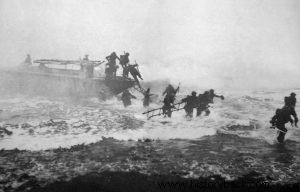
John Churchill, known as 'Mad Jack', was a distinctive figure of World War II who marched into battle with a bagpipe, a Scotch sword and a longbow, a characteristic weapon, the latter, of English archers in the Middle Ages. But was what was said about him true or a legend created by the British to raise their morale? In 1940 the British Expeditionary Force in France (BEF) was running to save itself from the Germans after the collapse of the French front. The goal of the British was to reach Dunkirk.
Amidst the gloom and demoralization one man remained undisturbed. He was "Fighting Mad Jack". It was May 27, 1940 when little Jack. Churchill was born in what was then British Ceylon in 1906. At the age of 20 he joined the British Army as an officer and stayed for 10 years. He resigned in 1936 and worked as a journalist, but also an actor. But with the outbreak of World War II in 1939, he returned to the army. He played an excellent bagpipe and was an archer with international distinctions. That morning in France, together with two of his men, he was in the French village of L'Epinette, when he saw five Germans approaching.
Calmly he took his bow and shot the first arrow at the main opponent, a sergeant, hitting him straight through the heart, killing him instantly. The Germans were surprised and moved away. Churchill returned to Britain and joined the famous Commandos. As a member of the 3rd Commando he was sent to Norway. On December 27, 1941, as the landing craft ramp was lowered Churchill, first, led his men to the enemy-held shore playing a Scottish war song on his bagpipes.
Then he drew his sword from his sheath and moved in the lead. As he said, "any officer who marched into battle without a sword was not well dressed"! In 1943, head of the 2nd Commando landed with his men in Sicily. On one occasion, with the help of a corporal, he captured 42 Germans. In 1944 he was sent to Yugoslavia to support Tito. There he was wounded and captured. The Germans captured him while he was playing the bagpipes. Thinking they had captured a relative of Winston Churchill (there was no relation), they sent him to the special POW camp on the grounds of the Sachsenhausen inferno.
But "Mad Jack" was not born to be a prisoner. Together with four other Britons he escaped from the camp. Although with a dislocated elbow, he managed to escape initially by stealing food and jumping from train to train. Finally he was arrested again and sent to a camp in Tyrol from where he again escaped. Returning to friendly lines and as Germany capitulated, he asked to be sent to the Burmese front to fight the Japanese. But the atomic bombs caught up and so he did not see action there.
In 1948 he was in Palestine. There, at the head of 12 men, he rescued a Jewish convoy carrying medical personnel and supplies under Arab attack, despite orders not to engage. But two of the cars were taken over by the Arabs and 77 Jews who were in them were massacred. After the incident he returned to Britain where he acted in the film "Ivanois" using his bow. He was then sent as an instructor to Australia. He finally retired in 1959. He died peacefully in 1996 at the age of 89.

"Mad Jack" at the head of his men, sword in hand (far right).

